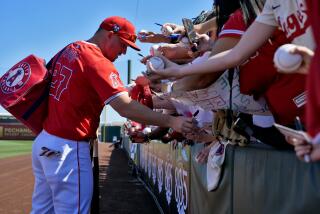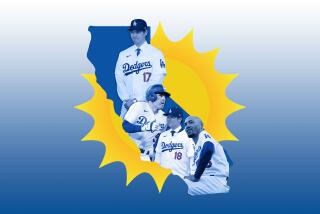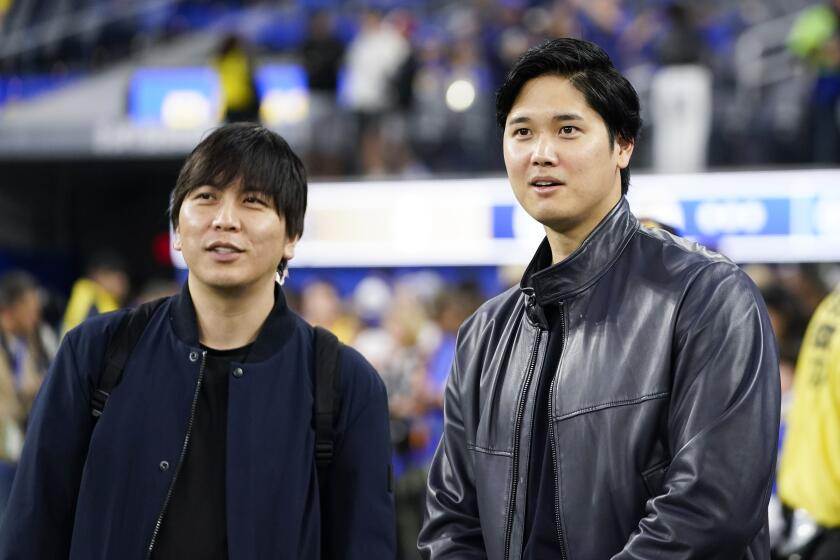Donnelly Has Gripping Story
So, how did this happen?
How did Brendan Donnelly emerge from those 10 years of minor league tribulation to become baseball’s dominant setup man, a bona-fide All-Star, whether he is on the American League team or not, and one of the most coveted Angels in trade talks that have become more urgent with the loss of Brad Fullmer?
How is it that a repertoire that failed to get Donnelly a major league opportunity until he arrived to stay with the Angels at the improbable age of 31 last season has produced a two-year run of relief pitching that Manager Mike Scioscia says is as good as he has ever seen?
There is probably more than one answer, but a lot of it, Donnelly said, comes down to the baseball he is delivering.
Or as he put it, “All those years in the minors, I probably just needed to be throwing a major league ball.”
Say what?
Isn’t one specification supposed to fit all? Isn’t the only difference between major and minor league baseballs supposed to be the stamp?
Well, in this era of second basemen as Babe Ruth, we know that not all balls come off the Rawlings assembly line exactly the same.
What Donnelly found, when first summoned by the Angels from triple A in April of last year, was that the major league balls were generally slicker and harder and had less of a seam.
“Like a cue ball,” he said, sitting at his locker.
“I remember thinking, ‘How am I supposed to throw one of these and what is going to happen when I do?’ ”
Shazam!
Donnelly discovered that not only could he still throw a 92-mph fastball and an 86-mph split finger, but that his long dormant slider was suddenly reborn.
A pitch that he’d seldom thrown in the minors, because it was “too loopy” and not hard enough, was now harder, less loopy and had this sweet break.
All of a sudden, in fact, it was two pitches in one.
A cross between a slider and a cut fastball, it was a pitch the right-handed Donnelly could run in on left-handers (who are hitting .133 against him this year), run away from right-handers (who are hitting .189) and “even give a little tilt to.”
It has been so effective in combination with his fastball and split finger that he now says, “I have two No. 1s [the fastball and slider] and a No. 2.”
He also says of the slider-cutter, “Without that pitch, I’m not here.”
Donnelly didn’t stay in April and didn’t stay in June last year.
He had to learn to pitch with it at the major league level, to incorporate the advice he was getting from closer Troy Percival and pitching coach Bud Black, and he went back to triple A after those first two stints to gain more command, to continue working with minor league instructor Mike Butcher, and wait again for the call, which he got July 13, nine days after his 31st birthday.
The results?
Well, setup men work in the shadow of the closers, but what Ron Davis was to Goose Gossage or Duane Ward was to Tom Henke or Jeff Nelson and Mike Stanton were to Mariano Rivera, Donnelly has been to Percival.
“He was great last year and he’s been phenomenal this year,” Black said.
Consider the numbers:
Donnelly led American League relievers last year in stranding inherited runners and in first-batter efficiency, and ranked second among all pitchers with 45 or more innings by limiting opposing hitters to a .184 average. Although Francisco Rodriguez stole the postseason spotlight, Donnelly held hitters to a .152 average in 11 appearances and was pivotal in the World Series, giving up only one hit in 7 2/3 shutout innings.
This year?
Well, it’s as if April followed October. He has stranded 18 of 21 inherited runners, retired 28 of 34 first batters, held hitters to a .161 average and leads the major leagues with an eye-popping earned-run average of 0.43 through 41 2/3 innings and 34 appearances.
“I take a lot of pride in minimizing damage,” Donnelly said. “I take a lot of pride and put a lot of focus on retiring that first batter. Good things happen when you get that first guy.”
One of the best things that could happen, and should happen, would be for Donnelly to receive an All-Star berth, the ultimate yardstick on how far and fast he has come in less than two years.
“It would be something special if it happened after, basically, just getting here,” he said. “It would be the ultimate respect to be voted in by peers. I get goose bumps just thinking about it.”
In the new process, players will elect most of the pitching staffs, but whether a deserving setup man can out-poll starters and closers is problematic, and some voters and hardened union members may reject Donnelly because he became a replacement player when under career duress during that ridiculous response by the owners to the players’ strike of 1994-95.
In addition, Scioscia will be unable to load his All-Star roster with Angels -- other All-Star managers have favored their own players in recent years -- because he gets only five selections, and all five may have to be spent selecting players from teams who aren’t otherwise represented. It’s an inane rule that Scioscia disagrees with but can’t avoid.
Of course, after 10 years of fast food and cheap motels, of going to bed at night wondering if he was wasting his life, of off-seasons spent laying water lines or working in pest control or even staying in Chattanooga, Tenn., when the season ended to work on the stadium maintenance crew (“I managed to install a door on the press box backwards,” Donnelly said), putting on a major league uniform and knowing where he will be from day to day are reward and tribute enough.
Then again, no one understands the business of baseball better than a player who has ridden as many buses or been released as many times as Donnelly.
He knows that the Angels, struggling in defense of their World Series title, may choose to deal from their bullpen strength, and as distressing as it might be if he were traded -- “I feel like, for the first time, I have a home, and this is where I want to be and stay” -- he knows there are other teams and opportunities out there. If that means going somewhere to become a closer? “I’d be more than happy to have that happen,” he said. “But I’m not looking to become a closer here because we have a great one and I’m happy in my role.”
The Angels are happy with him, and if it comes down to trading a superb setup guy making a modest $325,000 at a time when Percival has only a year left on his contract and has experienced recent physical problems ... well, it probably isn’t going to happen and Donnelly has traveled too many miles to worry about it.
He continues to heed the advice he got from an unlikely source in the summer of 1993, after he had just been released by the Chicago White Sox only a year into his pro career. He was tending bar in Albuquerque, thinking his career was over, when Darryl Strawberry, on triple-A rehabilitation with the Dodgers, came in.
“I introduced myself, told him what had happened, and said my career seemed to be finished before it had started,” Donnelly said. “I didn’t know better at the time, didn’t know the business, but Darryl told me players got released and started fresh all the time, that there was more than one team out there and that I shouldn’t quit if I had it in me to keep playing.”
Donnelly called Chuck Sheldon, a scout for the Chicago Cubs, and was pitching in the Cubs’ system two months after his White Sox release. “I know Darryl has had problems, but he was an inspiration and encouragement to me, and I always remember that when I’m talking to kids or young players,” Donnelly said. “You never know when, where and from whom those key words are going to come.”
Nor could Donnelly know, for certain, he would finally get a chance to throw that slicker, harder major league baseball.
More to Read
Go beyond the scoreboard
Get the latest on L.A.'s teams in the daily Sports Report newsletter.
You may occasionally receive promotional content from the Los Angeles Times.






